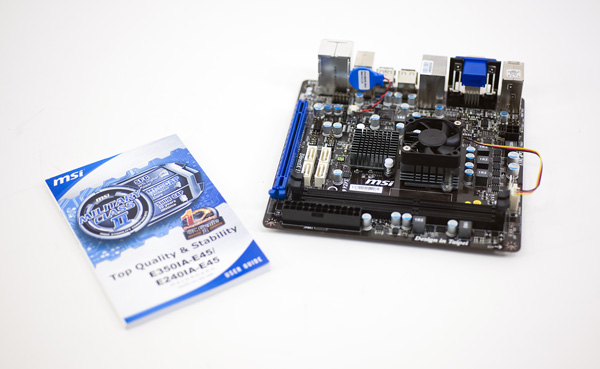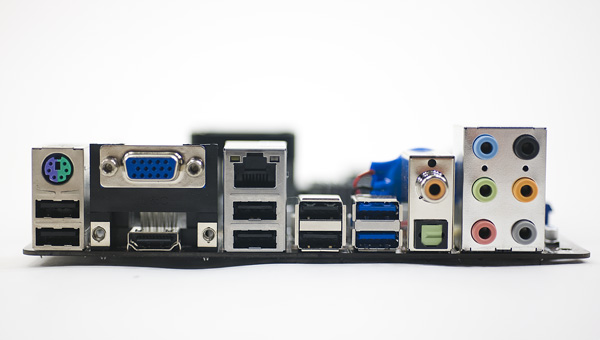The Brazos Review: AMD's E-350 Supplants ION for mini-ITX
by Anand Lal Shimpi on January 27, 2011 6:08 PM ESTThe Price: Around $100, The Motherboard: MSI's E350IA-E45
AMD expects most E-350 motherboards to sell for around $100 in etail. For lightly featured boards, I've heard this estimate is about right. It's once you start adding WiFi, passive cooling and other enhancements that costs creep up to around $130. Even at $130 that's not a bad deal. We're talking about better pricing than most ION boards but with much better performance.
AMD sent over the first Brazos motherboard ready for prime time, MSI's E350IA-E45. The mini-ITX board features two DDR3 DIMM slots (a Brazos feature, there's still only one 64-bit memory channel off of the APU), four 6Gbps SATA ports and a PCIe x16 slot (electrically x4). On the I/O panel MSI provides both VGA and HDMI out for video. For audio you have the options of running audio over HDMI, coax, optical or 1/8" stereo outputs. There are a surprising number of USB ports on the back of the board: 6 x USB 2.0 and 2 x USB 3.0 driven off of the very familiar NEC D7202 USB 3.0 controller. There are two USB 2.0 headers for front panel or case USB as well. There's unfortunately no WiFi support on board, all you get is a single Realtek RTL8111D 10/100/1000 ethernet port.

mini-ITX motherboard (right) and mini-ITX manual (left)
The MSI board doesn't support overclocking, so all results are at the CPU's stock 1.6GHz frequency.
Power is supplied by a standard 24-pin ATX PSU connector (older Atom/ION boards sometimes only used a 20-pin connector) as well as a 4-pin ATX12V connector. The Hudson FCH is passively cooled while the APU features a small, and unfortunately audible fan. ASUS is working on a passively cooled E-350 motherboard which I should have within the next week.























176 Comments
View All Comments
themw6 - Saturday, January 29, 2011 - link
Hi Anand, as many of us are interested in using zacate in a NAS - could you run a quick truecrypt benchmark? I'm especially interested in AES-256 performance. Additionally, network throughput would be great, too ;)Something else: you measured 24 watts idle power consumption. Could you provide more details on your test platform? Others had engineering samples with as little as 11 watts at idle. I'm guessing you used some 850W-rated PSU? ;) Anyway, thanks for the review!
MrSpadge - Saturday, January 29, 2011 - link
With such a low clock speed and such low power draw and a desktop platform, which can easily provide power but needs some more performance.. you'd think AMD would have put a proper Turbo mode in there. 1 thread 2.0 GHz, 2 threads 1.6 GHz - easy.MrS
rashire - Saturday, January 29, 2011 - link
First Thanks to Anand for doing a HTPC review for this chip, I've been waiting on this since your initial comments in Nov.But I'm kind of disappointed after reading the review. While it definitely looks like a better alternative to atom+ion i was just expecting a bit more horse power from it.
I was hoping for a product i was certain would have the power to do downloads, archive extraction and other CPU intensive processes in the background while doing 1080p playback or running an emulator in the foreground. And from the review i just don't see enough power to be sure my media and data-storage processes without potentially maxing out the CPU under certain combinations.
Looking forward to next gen discrete solution to replace my mid-tower HTPC.
GullLars - Sunday, January 30, 2011 - link
I'd like to see a clock for clock comparison of Bobcat, Athlon II, Phenom II, Atom, Core, Nehalem, and Sandy Bridge.From what i can see in these graphs, Bobcat performs about 60-90% of Athlon II clock for clock.
I look forward to seeing overclocking of bobcat :)
Malih - Sunday, January 30, 2011 - link
Zacate (board) ~$100WiFi ~$25
small Case ~$75
PSU ~$50
4GB RAM ~$50
widescreen LCD ~$125
storage ~$100
around $500 for a good enough complete system, but of course you can always get cheaper case, PSU, storage, LCD and 2GB RAM
THE_DOM!NAT0R - Monday, January 31, 2011 - link
The mini-ITX boards based on Brazos are quite good as it seems. They surpass Atom for HTPC's and have more features like more sata ports. I would like to see a comparison with about 5 mini-itx Brazos boards by Anand. Also, if you have a power supply that is rated for max efficiency at about 15-30 W, you can accurately compare the power figures between Brazos boards and Atom. I've seen some reviews and they use power supplies that are rated at about 300W; their lowest reasonable efficiency is 10% load, that isn't designed for 15<P<30.MrMilli - Monday, January 31, 2011 - link
I would really like to see a comparison against the Athlon II 250u.jamesgor13579 - Monday, January 31, 2011 - link
Until it can replace my ION/Linux/XBMC system, I am not interested. AMD has been doing well on the Linux front recently, but I don't know about their video decode.Metaluna - Monday, January 31, 2011 - link
I'm also interested in how these boards perform in Linux (or even if the new GPU is supported at all in current mainstream distros like Ubuntu 10.10). I'm interested in building a small nettop, mostly for web browsing but possibly HTPC use at some point.Jeffk464 - Tuesday, February 1, 2011 - link
"The good news is 1080i60 works just fine.Brazos’ GPU also fails all of our deinterlacing tests,"
The second sentence follows the first one and seems to directly contradict it. I was planning on buying one of these for a htpc and the ability to play 1080i60 as well as 1080p24 are absolutely critical. 1080i60 is one of the main standards of broadcast(over the air TV) and 1080p24 is the standard for blue ray. So my question then becomes since the author seems to have contradicted himself can brazos handle the interlaced 1080i60 content? This article should have cleared things up not made it more confusing.